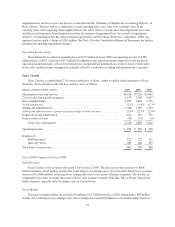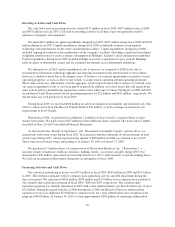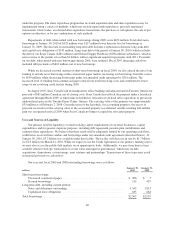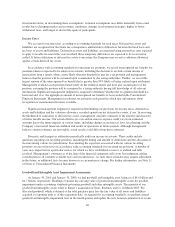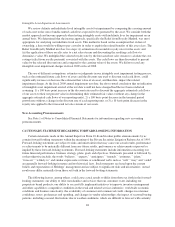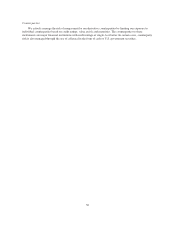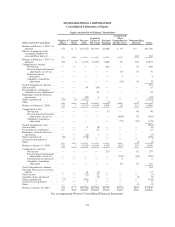Sears 2009 Annual Report Download - page 45
Download and view the complete annual report
Please find page 45 of the 2009 Sears annual report below. You can navigate through the pages in the report by either clicking on the pages listed below, or by using the keyword search tool below to find specific information within the annual report.turnover rates. Management monitors the content of merchandise in these groupings to prevent distortions that
would have a material effect on inventory valuation.
RIM inherently requires management judgment and certain estimates that may significantly affect the
ending inventory valuation, as well as gross margin. Among others, two significant estimates used in inventory
valuation are the level and timing of permanent markdowns (clearance markdowns used to clear unproductive or
slow-moving inventory) and shrinkage. Amounts are charged to cost of sales, buying and occupancy at the time
the retail value of inventory is reduced through the use of permanent markdowns.
Factors considered in the determination of permanent markdowns include current and anticipated demand,
customer preferences, age of the merchandise, fashion trends and weather conditions. In addition, inventory is
also evaluated against corporate pre-determined historical markdown cadences. When a decision is made to
permanently markdown merchandise, the resulting gross margin reduction is recognized in the period the
markdown is recorded. The timing of the decision, particularly surrounding the balance sheet date, can have a
significant effect on the results of operations.
Shrinkage is estimated as a percentage of sales for the period from the date of the last physical inventory to
the end of the fiscal year. Physical inventories are taken annually for all stores and inventory records are adjusted
accordingly. The shrinkage rate from the most recent physical inventory, in combination with historical
experience, is used as the basis for the shrinkage accrual following the physical inventory.
Self Insurance Reserves
We use a combination of third-party insurance and/or self-insurance for a number of risks including
workers’ compensation, asbestos and environmental, automobile, warranty, product and general liability claims.
General liability costs relate primarily to litigation that arises from store operations. Self-insurance reserves
include actuarial estimates of both claims filed and carried at their expected ultimate settlement value and claims
incurred but not yet reported. Our estimated claim amounts are discounted using a rate with a duration that
approximates the duration of our self-insurance reserve portfolio. Our liability reflected on the consolidated
balance sheets represents an estimate of the ultimate cost of claims incurred as of the balance sheet date. In
estimating this liability, we utilize loss development factors based on Company-specific data to project the future
development of incurred losses. Loss estimates are adjusted based upon actual claims settlements and reported
claims. These projections are subject to a high degree of variability based upon future inflation rates, litigation
trends, legal interpretations, benefit level changes and claim settlement patterns. Although we do not expect the
amounts ultimately paid to differ significantly from our estimates, self-insurance reserves could be affected if
future claim experience differs significantly from the historical trends and the actuarial assumptions.
Defined Benefit Retirement Plans
The fundamental components of accounting for defined benefit retirement plans consist of the compensation
cost of the benefits earned, the interest cost from deferring payment of those benefits into the future and the
results of investing any assets set aside to fund the obligation. Such retirement benefits were earned by associates
ratably over their service careers. Therefore, the amounts reported in the income statement for these retirement
plans have historically followed the same pattern. Accordingly, changes in the obligations or the value of assets
to fund them have been recognized systematically and gradually over the associate’s estimated period of service.
The largest drivers of losses in recent years have been the discount rate used to determine the present value of the
obligation and the actual return on pension assets. We recognize the changes by amortizing experience gains/
losses in excess of the 10% corridor into expense over the associate service period and by recognizing the
difference between actual and expected asset returns over a five-year period.
Holdings’ actuarial valuations utilize key assumptions including discount rates and expected returns on plan
assets. We are required to consider current market conditions, including changes in interest rates and plan asset
45


